| dc.contributor.advisor | Jesús A. del Alamo. | en_US |
| dc.contributor.author | Wu, Yufei, Ph. D. Massachusetts Institute of Technology. Department of Electrical Engineering and Computer Science | en_US |
| dc.contributor.other | Massachusetts Institute of Technology. Department of Electrical Engineering and Computer Science. | en_US |
| dc.date.accessioned | 2017-10-30T15:28:34Z | |
| dc.date.available | 2017-10-30T15:28:34Z | |
| dc.date.copyright | 2017 | en_US |
| dc.date.issued | 2017 | en_US |
| dc.identifier.uri | http://hdl.handle.net/1721.1/112033 | |
| dc.description | Thesis: Ph. D., Massachusetts Institute of Technology, Department of Electrical Engineering and Computer Science, 2017. | en_US |
| dc.description | Cataloged from PDF version of thesis. | en_US |
| dc.description | Includes bibliographical references (pages 121-129). | en_US |
| dc.description.abstract | AlGaN/GaN High Electron Mobility Transistors (HEMTs) have enjoyed tremendous market growth in RF power amplifiers over the past decades. In the quest for enhancing the operating frequency of GaN HEMTs, there has been a great effort to scale down the gate length. Maintaining acceptable short-channel effects requires shrinking the barrier thickness at the same time. However, a limitation exists since there is a minimum barrier thickness that is needed to obtain a sufficiently high two-dimensional electron gas density. One possible solution to this problem is the use of a new barrier material, i.e., InAlN. Due to its high spontaneous polarization, if InAlN is used as a barrier material in GaN HEMTs, a much smaller layer thickness is required compared with conventional HEMTs. This enables further barrier thickness scaling and therefore gate length scaling and a higher frequency response. However, as a relatively new structure, reliability studies of InAlN/GaN HEMTs are still lacking. Solid reliability is essential before the wide commercial deployment of this new technology. This thesis investigates the most relevant degradation mechanisms under important stress regimes, aiming at building a comprehensive understanding of InAIN/GaN HEMT reliability. Through investigating various voltage, current, and temperature stress levels, we have identified one recoverable degradation mechanism as well as three permanent degradation mechanisms. Under high drain voltage, hot-electron trapping results in temporary drain current decrease and drain resistance increase. In addition, under high drain voltage but relatively low drain current level, permanent negative threshold voltage shift and drain current increase have been observed. We attribute the phenomena to dehydrogenation of pre-existing defects in GaN channel by hot electrons. Under high positive gate bias, defect generation in the AIN interlayer due to high electric field across AIN has proven to be responsible for the observed gate leakage current increase. Also, under high-power stress conditions, positive threshold voltage shift and maximum drain current decrease have been consistently observed. We verified through both thermal stress experiments and Transmission Electron Microscopy (TEM) analysis that Schottky gate sinking is the cause. This work provides fundamental understanding of potential reliability concerns in InAlN/GaN HEMTs and is essential in accelerating the future commercialization of this promising technology. | en_US |
| dc.description.statementofresponsibility | by Yufei Wu. | en_US |
| dc.format.extent | 129 pages | en_US |
| dc.language.iso | eng | en_US |
| dc.publisher | Massachusetts Institute of Technology | en_US |
| dc.rights | MIT theses are protected by copyright. They may be viewed, downloaded, or printed from this source but further reproduction or distribution in any format is prohibited without written permission. | en_US |
| dc.rights.uri | http://dspace.mit.edu/handle/1721.1/7582 | en_US |
| dc.subject | Electrical Engineering and Computer Science. | en_US |
| dc.title | Reliability of W-Band InAIN/GaN High Electron Mobility Transistors | en_US |
| dc.type | Thesis | en_US |
| dc.description.degree | Ph. D. | en_US |
| dc.contributor.department | Massachusetts Institute of Technology. Department of Electrical Engineering and Computer Science | |
| dc.identifier.oclc | 1006384205 | en_US |
